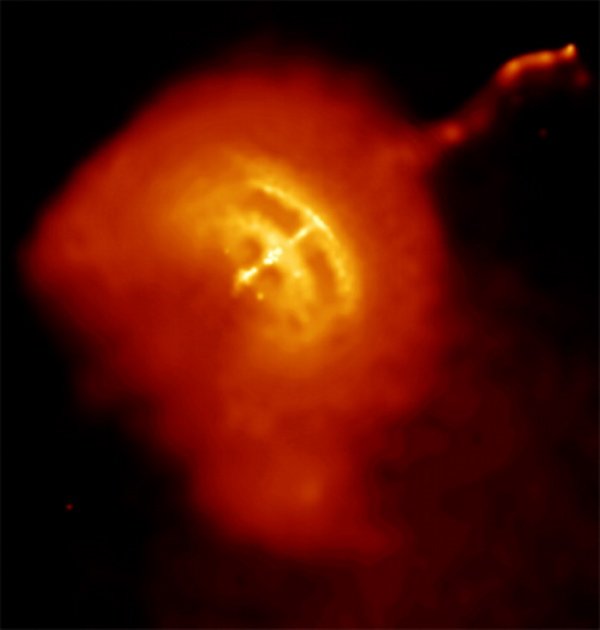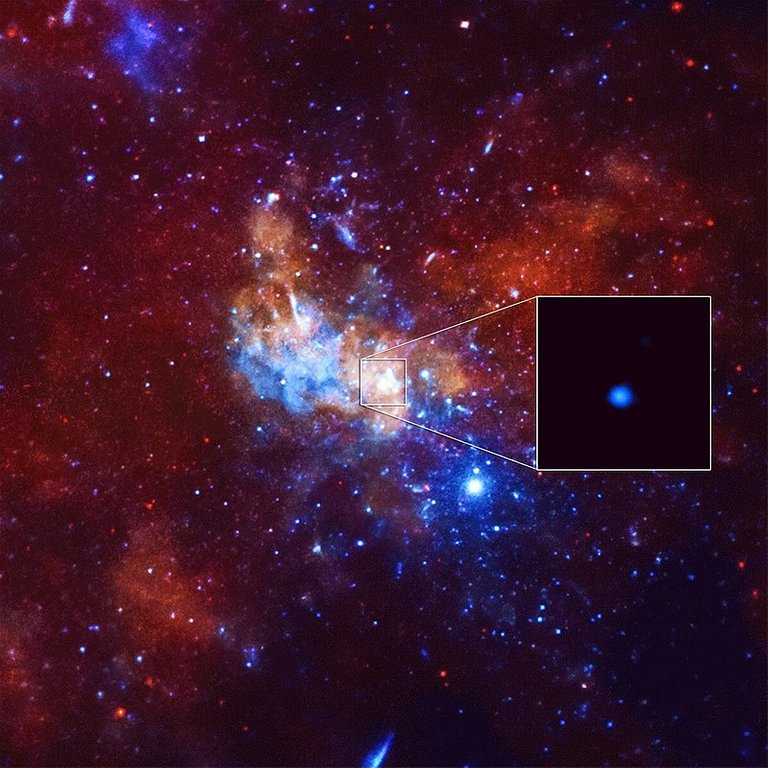From beginning to the end

(:Offtopic: This is my first post to steemit.com . So please advice me if anything is wrong:)
Lets start our journey...
Imagine an enormous cloud of gas and dust many light-years across. Clouds of gas and dust, known as nebulae.
Eagle nebula pillars

Gravity, as it always does, tries to pull the materials together. A few grains of dust collect a few more, then a few more, then more still. Eventually, enough gas and dust have been collected into a giant ball that, at the center of the ball, the temperature (from all the gas and dust bumping into each other under the great pressure of the surrounding material) reaches 15 million degrees or so. A wondrous event occurs.... nuclear fusion begins and the ball of gas and dust starts to glow. A new star has begun its life in our Universe. The exact lifetime of a star depends very much on its size.
Throughout their lives, stars fight the inward pull of the force of gravity. It is only the outward pressure created by the nuclear reactions pushing away from the star's core that keeps the star “intact”. But these nuclear reactions require fuel, in particular, hydrogen. Eventually, the supply of hydrogen runs out and the star begins its demise. And ultimately it starts “Beginning of the End”.
After millions to billions of years, depending on their initial masses, stars run out of their main fuel - hydrogen. Once the ready supply of hydrogen in the core is gone, the helium core now starts to contract further and reactions begin to occur in a shell around the core. The core is hot enough for the helium to fuse to form carbon. The outer layers begin to expand, cool and shine less brightly. Without the outward pressure generated by these reactions to counteract the force of gravity, the outer layers of the star begin to collapse inward toward the core. Just as during formation, when the material contracts, the temperature and pressure increase. This newly generated heat temporarily counteracts the force of gravity, and the outer layers of the star are now pushed outward. The star expands to larger than it ever was during its lifetime -- a few to about a hundred times bigger. The star has become a red giant.
Mira 1997

In the Sun's case, this will mean the fiery end of all the inner planets of our Solar System, which might also include the Earth; but don't worry, this won't happen for another 5,000,000,000 years.
What happens next in the life of a star depends on its initial mass. Very large stars (red giants) are often called Super Giants. These stars have diameters up to 1000 times that of the Sun and have luminosities often 1,000,000 times greater than the Sun. However, in a Sun-sized star, this process might only take a few minutes! The atomic structure of carbon is too strong to be further compressed by the mass of the surrounding material. The core is stabilized and the end is near. The star will now begin to shed its outer layers as a diffuse cloud called a planetary nebula. Eventually, only about 20% of the star’s initial mass remains and the star spends the rest of its days cooling and shrinking until it is only a few thousand miles in diameter. It has become a white dwarf. White dwarfs are stable because the inward pull of gravity is balanced by the electrons in the core of the star repulsing each other. With no fuel left to burn, the hot star radiates its remaining heat into the coldness of space for many billions of years. In the end, it will just sit in space as a cold dark mass sometimes referred to as a black dwarf.
Fate has something very different, and very dramatic, in store for stars which are some 5 or more times as massive as our Sun. After the outer layers of the star have swollen into a red supergiant (i.e., a very big red giant), the core begins to yield to gravity and starts to shrink. As it shrinks, it grows hotter and denser, and a new series of nuclear reactions begin to occur, temporarily halting the collapse of the core. However, when the core becomes essentially just iron, it has nothing left to fuse (Because iron is the most tightly bound nucleus something like the "break-even point" between fusion and fission, the star is no longer able to produce energy in the core via further nuclear burning stages.) and fusion ceases. In less than a second, the star begins the final phase of its gravitational collapse. The core temperature rises to over 100 billion degrees as the iron atoms are crushed together. The repulsive force between the nuclei overcomes the force of gravity, and the core recoils out from the heart of the star in an explosive shock wave. As the shock encounters material in the star's outer layers, the material is heated, fusing to form new elements and radioactive isotopes. In one of the most spectacular events in the Universe, the shock propels the material away from the star in a tremendous explosion called a supernova.
A star set to explode


The material spews off into interstellar space -¬ perhaps to collide with other cosmic debris and form new stars, perhaps to form planets and moons, perhaps to act as the seeds for an infinite variety of living things. That’s why I like to call myself a stardust.
Unlike in smaller stars, where the core becomes essentially all carbon and stable, the intense pressure inside the supergiant causes the electrons to be forced inside of (or combined with) the protons, forming neutrons. In fact, the whole core of the star becomes nothing but a dense ball of neutrons. It is possible that this core will remain intact after the supernova, and be called a neutron star. However, if the original star was very massive (say 15 or more times the mass of our Sun), even the neutrons will not be able to survive the core collapse and a black hole will form!
That’s the endpoint for a star. Now I’m going to discuss some facts about Supernova, Neutron Stars & Pulsars.
Supernova
The Crab Nebula is a pulsar wind nebula associated with the 1054 supernova

At first we should take a look at what it takes to transform into a supernova. We previously have seen that because iron is the most tightly bound nucleus, after passing DWARF phase the star is no longer able to produce energy in the core via further nuclear burning stages. Nuclear reactions will continue, however, because of the extremely high temperatures in the massive star's core. These further reactions have a devastating effect on the star, because they take energy out of the core. At such high temperatures and densities, the gamma-ray photons present in the core have sufficient energy to destroy the heavy nuclei produced in the many stages of nuclear reactions.
This process, called photodisintegration undoes the work of a stellar lifetime in the core and removes the thermal energy necessary to provide pressure support. The result is a catastrophic collapse of the core, which cannot be halted until the core has shrunk to a size of about 10km and a density of the order of 200 million tons/cm3. Under such extreme conditions, electron degeneracy cannot support the stellar core, and the free electrons are forced together with protons to form neutrons.
The neutrinos, which escape directly from the core result in further energy loss and even faster collapse. The core collapses so rapidly that it effectively collapses out from under the stellar envelope. When the core has collapsed down to a size of about 10 km, neutron degeneracy sets in causing the core to stiffen and the infalling material from the envelope to rebound in a shockwave outward from the core. This shockwave drives the remaining material from the envelope outward, compressing it and heating it as it moves through. The net result is the formation of a neutron star in the stellar core and the total disruption of the remainder of the star with the liberation of about 1053ergs of energy in neutrinos and 1051ergs of kinetic and luminous energy. (The luminous energy release is about the amount of energy that the sun will release in its 10-billion-year lifetime). There are two general types of Supernova: -
Type I: These occur in binary star systems in which gas from one star falls on to a white dwarf, causing it to explode.
Type II: These occur in stars ten times or more as massive as the Sun, which suffer runaway internal nuclear reactions at the ends of their lives, leading to an explosion. They leave behind neutron stars and black holes. Supernova are thought to be main source of elements heavier than hydrogen and helium.
Neutron Stars & Pulsars
Composite optical/X-ray image of the Crab Nebula, showing synchrotron emission in the surrounding pulsar wind nebula, powered by injection of magnetic fields and particles from the central pulsar.
A neutron star is an incredibly compact core that remains after a supernova event. Neutron stars are typically about ten miles in diameter, have about 1.4 times the mass of our Sun, and spin very rapidly (one revolution takes mere seconds!). Neutron stars are fascinating because they are the densest objects known. Due to its small size and high density, a neutron star possesses a surface gravitational field about 300,000 times that of Earth. Neutron stars also have very intense magnetic fields - about 1,000,000,000,000 times stronger than Earth's. Neutron stars may "pulse" due to electrons accelerated near the magnetic poles, which are not aligned with the rotation axis of the star. These electrons travel outward from the neutron star, until they reach the point at which they would be forced to travel faster than the speed of light in order to still co-rotate with the star. At this radius, the electrons must stop, and they release some of their kinetic energy in the form of X-rays and gamma rays. External viewers see these pulses of radiation whenever the magnetic pole is visible. The pulses come at the same rate as the rotation of the neutron star, and thus, appear periodic. Neutron stars which emit such pulses are called pulsars.
The Vela Pulsar and its surrounding pulsar wind nebula.

Detection of an unusually bright X-ray flare from Sagittarius A, a supermassive black hole in the center of the Milky Way galaxy.
Happy Physics!
Source and for more:
https://en.wikipedia.org For (Nebulae, Protostars, Main Sequence Star, Red Giant, Planetary Nebula, White Dwarf, Black Dwarf, Red Supergiant, supernova, Neutron Star, Black Hole and much more)
http://www.schoolsobservatory.org.uk/learn/astro/stars
http://www.physicsoftheuniverse.com/topics_blackholes_stars.html
http://www.astro.keele.ac.uk/workx/starlife/StarpageS_26M.html
Congratulations @dolon! You have completed some achievement on Steemit and have been rewarded with new badge(s) :
Click on any badge to view your own Board of Honnor on SteemitBoard.
For more information about SteemitBoard, click here
If you no longer want to receive notifications, reply to this comment with the word
STOPIf you want to support the SteemitBoard project, your upvote for this notification is welcome!
Hi you follow me and i follow you back?
:)
Nice topic! I love to read this kind of topics, and I've also read that there's is a new second blackhole is living in our galaxy right?
& maybe you should put some pictures in it.
Thanks
yep there may be a secondary one, study is going on it.
Here is the brief explanation.
http://www.nao.ac.jp/en/news/science/2016/20160115-nro.html
Very nice, especially for a first post!
thanks 😀😀